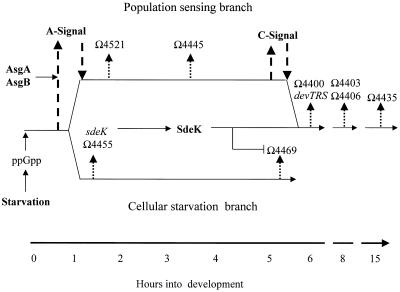FIG. 4.
Model for early developmental-gene expression. Development is initiated by amino acid limitation, which activates the stringent response mediated by the ribosome-associated protein RelA. RelA activation induces an increase in the level of (p)ppGpp, which activates the cellular starvation pathway and, in conjunction with AsgA and AsgB, leads to the production of A-signal (upward-pointing, broadly dashed arrow on left) and activation of the population-sensing pathway. C-signal, a second extracellular signal required for regulation of coordinated cell movement and gene expression, lies on the population-sensing branch and is depicted by the upward-pointing, broadly dashed arrow on the right. Genes expressed along the two different branches are designated by thinner, more narrowly dashed arrows at the time of activation. The two branches merge at approximately 6 h, at which point both C-signal (downward-pointing, broadly dashed arrow on right) and SdeK become necessary for gene expression. The model also shows the inhibitory effect (bent tipless arrow) of SdeK on the expression of Ω4469.

